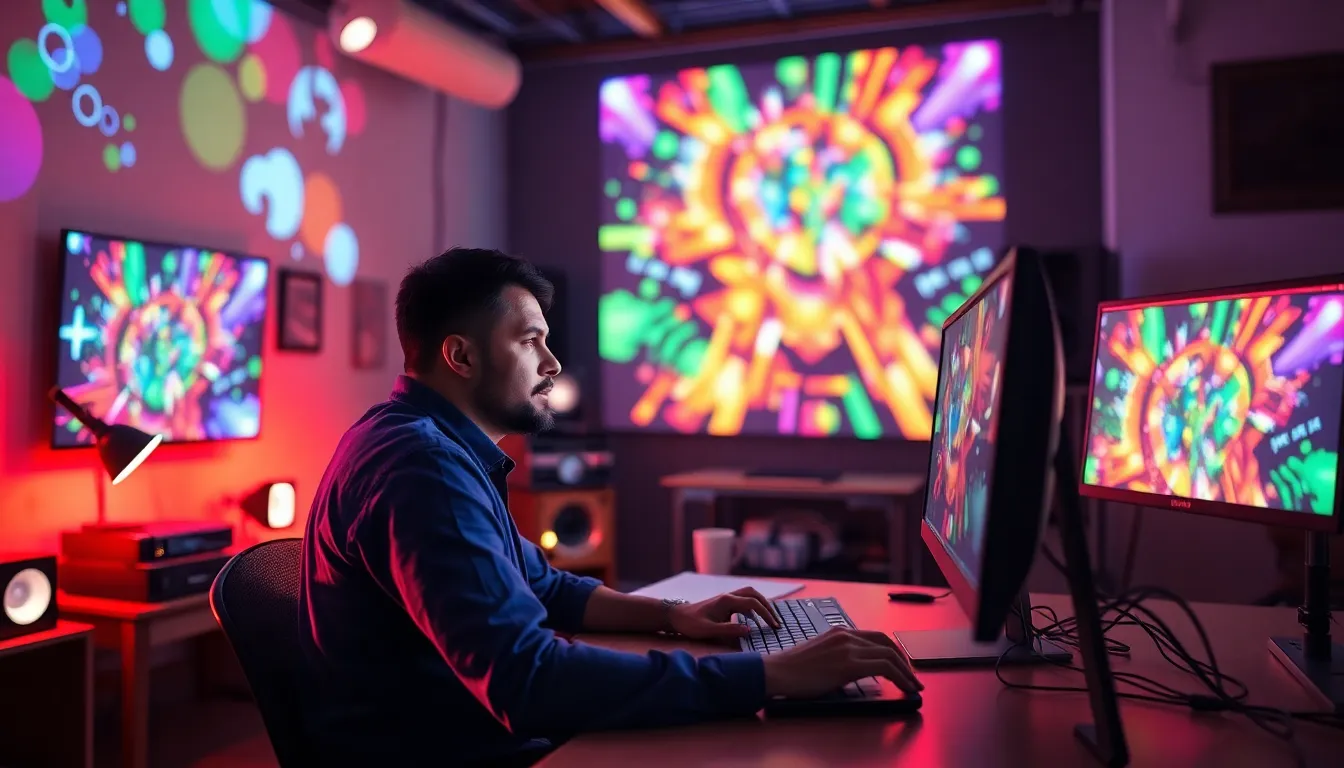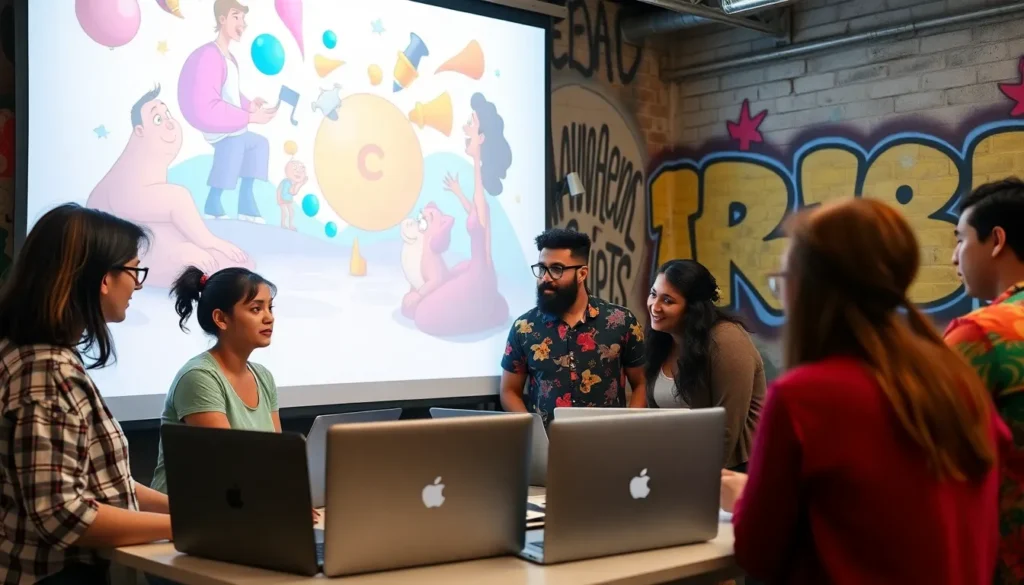In a world where creativity knows no bounds, projection mapping software is the magic wand every artist dreams of. Imagine transforming ordinary walls into stunning visual masterpieces without breaking the bank. That’s right—free projection mapping software is here to save the day and your wallet.
Table of Contents
ToggleOverview of Free Projection Mapping Software
Free projection mapping software offers tools that transform static surfaces into dynamic displays. Various options exist, enabling artists and enthusiasts to explore this captivating medium without financial barriers. Notable software includes Blender, which provides 3D modeling along with robust projection mapping capabilities.
OpenFrameworks stands out due to its open-source nature, facilitating customizations perfect for developers. Another option, MadMapper, allows users to easily map and control projections. Its intuitive interface simplifies the creative process for both beginners and experienced users.
Resolume Arena often attracts attention for its extensive features, though its free version has limitations on the number of outputs it supports. While slightly more advanced, TouchDesigner offers free licenses, ideal for students or individuals wanting to create experimental projects.
Artists can experiment with MapMap, an open-source solution that supports various multimedia formats. This software is notable for its flexible UI and compatibility with multiple devices. Each platform presents unique advantages, making the selection process crucial based on specific project requirements.
Understanding the features and limitations of each software plays an essential role in maximizing the creative potential. Artists will benefit from exploring tutorials and community forums that accompany these applications, enhancing their skills and knowledge base. The combination of free tools and extensive online resources empowers individuals to push the boundaries of their artistic expressions through projection mapping.
Features to Look for in Projection Mapping Software

When evaluating projection mapping software, several key features enhance user experience and creative output. Understanding these can guide artists in maximizing their artistic potential.
User Interface
An intuitive user interface simplifies the learning curve for beginners and enhances productivity for professionals. Look for software with a clean layout and accessible toolset. Effective navigation aids in quickly locating essential functions, which saves time during projects. Additionally, customizable interfaces allow users to tailor their workspace to individual preferences.
Compatibility
Compatibility with various operating systems ensures software operates smoothly across different platforms. Check if the software runs on Windows, macOS, or Linux to suit specific needs. Integrating with other creative applications, like 3D modeling software or video editing tools, expands creative possibilities. Working with multiple devices enhances flexibility in project execution, streamlining the creative process.
Supported File Formats
Support for a wide range of file formats maximizes versatility in projection mapping projects. Essential formats include images (JPEG, PNG), videos (MP4, AVI), and 3D models (OBJ, FBX). Software that accommodates various formats allows artists to incorporate diverse media types seamlessly. Ensuring compatibility with popular formats enables smoother workflows and enhances the overall output quality.
Popular Free Projection Mapping Software Options
Various free projection mapping software options allow artists to create stunning visual displays without financial burden. The following software highlights essential features and benefits.
Software 1: Blender – Features and Benefits
Blender excels in 3D modeling and rendering, making it a versatile tool for projection mapping projects. A comprehensive set of features includes powerful animation tools and high-quality rendering options. Artists appreciate its ability to create intricate models and animations with precision. Community support offers extensive tutorials for new users. Many users find the open-source model advantageous, allowing for continuous updates and improvements.
Software 2: OpenFrameworks – Features and Benefits
OpenFrameworks provides a creative toolkit for artists and developers interested in interactive installations. Its open-source nature allows for extensive customization and flexibility. Users can build unique applications tailored to specific project needs. The software supports a variety of programming languages, promoting adaptability. Collaborations with the vibrant community yield numerous resources, enhancing the overall user experience.
Software 3: MadMapper – Features and Benefits
MadMapper emphasizes its user-friendly interface, appealing to both beginners and experienced users. Users can easily map content onto surfaces, simplifying the projection process. The software’s support for multiple outputs caters to large-scale installations effectively. Real-time performance ensures seamless interactions during presentations. Extensive integration with various media formats allows for creative experimentation, making it an excellent choice for artists.
Getting Started with Free Projection Mapping Software
Exploring free projection mapping software can open doors to creative possibilities. This section outlines installation processes and offers basic usage tips to help artists begin their journey.
Installation Process
Installation varies across different software. For Blender, download the latest version from the official website, then follow the installation prompts. OpenFrameworks requires moving files into a project folder and configuring the settings. MadMapper installation simply involves downloading the software and running the setup. Resolume Arena provides a limited free download, so users must complete the setup wizard to install. TouchDesigner allows easy installation through a direct download; installation instructions appear once the download completes. MapMap’s installation is straightforward, requiring only the extraction of the zipped file. Users should ensure compatibility with their operating systems before installation.
Basic Usage Tips
Understanding basic functionality enhances the creative process. For Blender, mastering 3D modeling basics lays a solid foundation for projection mapping. OpenFrameworks users benefit from diving into the extensive documentation to learn about customizing their projects. MadMapper facilitates easy mapping by using intuitive tools for aligning visuals with surfaces. Resolume Arena allows users to experiment with video layering for dynamic displays, enhancing visual storytelling. In TouchDesigner, exploring node-based programming opens opportunities for creating interactive projections. MapMap’s simple interface allows quick adjustments without extensive training. Users should explore community forums and tutorials to accelerate their learning.
Exploring free projection mapping software opens up a world of creative possibilities for artists and developers alike. With a variety of options available each offering unique features and capabilities it’s easier than ever to transform spaces with stunning visuals. Whether one prefers the powerful tools of Blender or the user-friendly interface of MadMapper there’s something for everyone.
Taking advantage of these free resources not only fosters artistic growth but also encourages collaboration within the community. As individuals experiment and share their experiences they contribute to a vibrant ecosystem of creativity and innovation. Embracing these tools can lead to groundbreaking projects that captivate audiences and redefine artistic expression.










